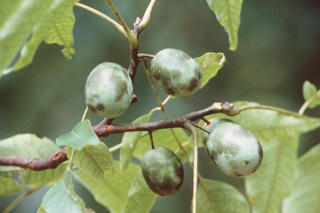Choerospondias axillaris
Contents
Nomenclature
Other Names:
Historical Use of Choerospondias axillaris
Choerospondias axillaris in Traditional Chinese Medicine
Background
Chinese Name (pinyin): Guangzao
Chinese Name :
Common Name :Axillary Choerospondias Fruit
Specific Name : Fructus choerospondiatis
Scientific Name:
Collection : The drug is collected in autumn when ripe, removed from foreign matter and dried.
Description : Ellipsoid or subovoid, 2 - 3cm. 1.4 - 2 cm in diameter. Externally blackish brown or brown, somewhat lustrous, irregularly shrunken, showing a fruit stalk scar at the base. Pulp thin, brown. Texture hard and brittle. Kernel subovoid, yellowish brown, apex having 5 ocassionally 4 or 6 distinct small holes, each possessing a seed. Odorless, taste sour.
Identification : 1.Powder: Brown, stone cells of endocarp subrounded, elliptical, fusiform, rectangular or irregular, some elongated to fibre like or branched, 14 - 72µm in diameter, 25 - 294µm long with thickened walls and distinct pit canals, lumina containing pale yellowish brown contents. Fibres oof endocarp lignified with thickened or slightly thickened walls, crisscross arranged and some of lumina containing yellowish brown contents. Cells of exocarp subpolygonal in lateral view, containing brown contents and subrectangular in lateral view, radially elongated, the outer and redial walls cutinized-thickened. Parenchymatous cells of mesocarp containing cluster and few prisms of calcium oxalate, the clusters, 17 - 42µm in diameter, prisms rhomboid or irregular, 10 - 48µm long, 7 - 27µm in diameter.2.To 1g of the powder add 10ml of methanol, heat under reflux for 10 minutes, filter. Spot the filtrate on a piece of filter paper, spray with 0.05% solution of bromophenolblue in ethanol, a yellow color is produced on a blue background.3.To 2g of the powder add 20ml of 70% ethanol, heat under reflux for 15 minutes, filter. Evaporate the filtrate to dryness, dissolve the residue in 10ml of ethyl acetate and filter. Evaporate 1ml of the filtrate to dryness in a porcelain dish, add 1ml of saturated solution of boric acid in acetone and 1ml of 10% citric acid solution in acetone, a yellow color is produced. Evaporate the solution to dryness. Observe under ultra violet light (365nm), a yellowish green fluorescence is shown. Evaporate another 1ml of the filtrate to dryness, dissolve the residue in 1ml of methanol, add 3 - 4 drops of aluminum chloride TS, the yellow color becomes slightly deep. Spot the solution to a piece of filter paper, examine under ultra violet light (365nm), a yellow green fluorescence is shown.
Processing :
Action : To promote the flow of qi and blood, to replenish the heart and allay excitement.
Indication : stagnation of qi and blood with chest pain, palpitation, shortness of breath, preoccupation
Precautions :
Dosage : 1.5 to 2.5 g.
Storage : Preserve in a cool and dry place.
Synonymns for Choerospondias axillaris
Patent Medicines and Medicines with Multiple Ingredients that include Choerospondias axillaris
Pharmaceutical Information
Chemical Constituents
Evidence or the Use of Choerospondias axillaris in the Treatment of Epilepesy
Basic Science
Animal Studies
Cohort, Case-Control and Non-Randomized Trials
Randomized Controlled Trials
Meta-Analysis
1st Five Results: pubmed search
Yongkang Xiao, Yu Hou, Huixue Zhou, Gayo Diallo, Marcelo Fiszman, Julian Wolfson, Li Zhou, Halil Kilicoglu, You Chen, Chang Su, Hua Xu, William G Mantyh, Rui Zhang
Repurposing non-pharmacological interventions for Alzheimer's disease through link prediction on biomedical literature.
Sci Rep: 2024, 14(1);8693
[PubMed:38622164]
[WorldCat.org]
[DOI]
(I e)
Weiwei Rong, Qilin Shi, Yuru Yang, Weiyi Su, Mingna Li, Minni Qin, Shuang Bai, Qing Zhu, Andong Wang
Fructus choerospondiatis: A comprehensive review of its traditional uses, chemical composition, pharmacological activities, and clinical studies.
J Ethnopharmacol: 2024, 323;117696
[PubMed:38171468]
[WorldCat.org]
[DOI]
(I p)
Puja Das, Prakash Kumar Nayak, Baskaran Stephen Inbaraj, Minaxi Sharma, Radha Krishnan Kesavan, Kandi Sridhar
##Title##
Foods: 2023, 12(20);
[PubMed:37893616]
[WorldCat.org]
[DOI]
(P e)
Yongkang Xiao, Yu Hou, Huixue Zhou, Gayo Diallo, Marcelo Fiszman, Julian Wolfson, Halil Kilicoglu, You Chen, Chang Su, Hua Xu, William G Mantyh, Rui Zhang
Repurposing Non-pharmacological Interventions for Alzheimer's Diseases through Link Prediction on Biomedical Literature.
medRxiv: 2023;
[PubMed:37292731]
[DOI]
(I e)
Yang Ye, Wenxin Deng, Anjiao Li, Yingting Wu, Xianling Yuan, Yang Wang
##Title##
Food Sci Biotechnol: 2023, 32(8);1039-1047
[PubMed:37215251]
[WorldCat.org]
[DOI]
(I e)
